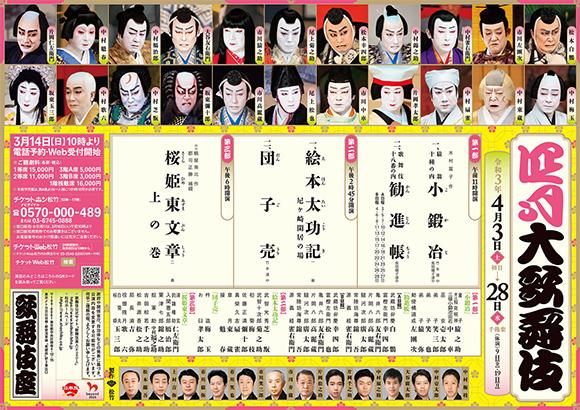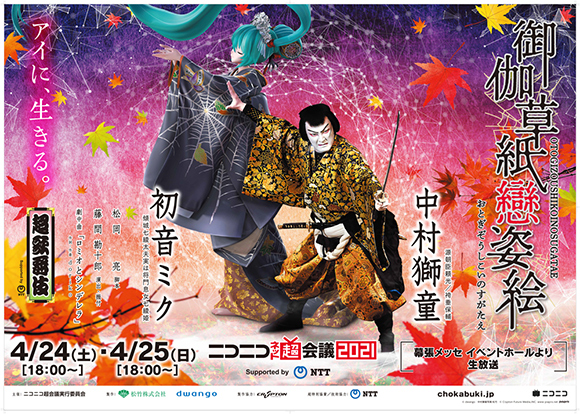| APRIL 2021 |
| Japan's Central Government has declared a third state of emergency due to the coronavirus (COVID-19) pandemic with new restrictions imposed in several areas: T˘ky˘ Metropolis, ďsaka Prefecture, Ky˘to Prefecture and Hy˘go Prefecture. As a consequence, Kabuki performances at the Kabukiza have to stop from the 25th of April 2021. |
|
4 shows in T˘ky˘ (Kabukiza, Makuhari Messe), 1 show in Nagoya (Misonoza),
|
| Kabukiza (T˘ky˘) |  |
| Dates | 3 ~ 24 Shigatsu ďkabuki April Grand Kabuki |
| 1st program | |
| 2nd program | |
| 3rd program |
Sakura Hime Azuma Bunsh˘ |
| Casting |
Living National Treasure Kataoka Nizaemon, Living National Treasure Band˘ Tamasabur˘, Living National Treasure Nakamura T˘z˘, Matsumoto Haku˘, Nakamura Shikan, Onoe Kikunosuke, Nakamura Jakuemon, Nakamura Baigyoku, Nakamura Kaishun, Nakamura Ganjir˘, Nakamura Senjaku, Ichikawa Ennosuke, Matsumoto K˘shir˘, Kataoka Takatar˘, Nakamura Kinnosuke, Ichikawa Sadanji, Band˘ Yajűr˘, Nakamura Karoku, Ichikawa Chűsha, Nakamura Kazutar˘, Nakamura Baishi, Onoe Matsuya, ďtani Tomoemon, Ichikawa Komaz˘, Ichikawa Emiya, Ichikawa Emisabur˘, Ichikawa En'ya, Kamimura Kichiya, Matsumoto Kingo, Ichikawa Juen, Kataoka Matsunosuke, ďtani Hirotar˘, Kataoka Sennosuke, Nakamura Fukunosuke |
| Comments |
The three Grand Kabuki performances at the Kabukiza! The second item in the first program, the dance-drama "Kanjinch˘", is divided into two subprograms, A and B. The roles of Musashib˘ Benkei and Togashi Saemon will be played by Matsumoto Haku˘ and Matsumoto K˘shir˘ in the A subprogram and by Matsumoto K˘shir˘ and Onoe Matsuya in the B subprogram. The A subprogram is staged the 3rd, 5th, 7th, 10th, 12th, 14th, 16th, 18th, 21st, 23rd, 25th and 27th of April 2021. The B subprogram is staged the 4th, 6th, 8th, 11th, 13th, 15th, 17th, 20th, 22nd, 24th, 26th and 28th of March 2021. There is no performance the 9th and the 19th of April 2021.
|
 |
| Misonoza (Nagoya) |  |
| Dates | 10 ~ 20 April 2021 Ichikawa Ebiz˘ Tokubetsu K˘en Ichikawa Ebiz˘ Special Performances |
| Program |
Benten Musume Meo no Shiranami
|
| Casting |
Ichikawa Ebiz˘, Nakamura Kotar˘, Ichikawa Udanji, Kataoka Ichiz˘, Ichikawa Omez˘, Ichikawa Kudanji, ďtani Hiromatsu |
| Comments |
The April Kabuki program at the Misonoza with a troupe led by the young star Ichikawa Ebiz˘.
|
 |
| Kanamaruza (Konpira) |
| Dates | Shikoku Konpira Kabuki ďshibai Shikoku Konpira Kabuki Grand Theatre |
| MatinÚe |
??? |
| Evening |
??? |
| Casting |
??? |
| Comments |
Due to heavy renovation works at the Kanamaruza, started in October 2020, the 37th edition of the Spring Kabuki performance Shikoku Konpira Kabuki ďshibai at the Kanamaruza on Shikoku Island, is not holden this year! |
| Shungy˘ Special Tour | |
| Dates | 30 March ~ 4 April 2021 Shungy˘ Tokubetsu K˘en The Dawn of Spring Special Performances |
| Program |
T˘ku K˘nÔ |
| Casting |
Nakamura Kankur˘, Nakamura Shichinosuke, Nakamura Tsurumatsu, Nakamura Kantar˘, Nakamura Ch˘zabur˘, Nakamura Kosabur˘, Nakamura Ich˘, Sawamura Kunihisa |
| Comments |
The 2nd edition of the Spring Tour of the Nakamuraya guild with performances in 4 cities (5 venues). The second item (T˘ku K˘nÔ) in this program is a talk on stage (literally 'Talk Corner'). In April, the troupe performs in Nishinomiya at the Hy˘go Performing Arts Center the 2nd of April and in T˘ky˘ at the Line Cube Shibuya the 3rd of April and at the Shinjuku Bunka Center the 4th of April.
|
| Makuhari Messe (Chiba) |
| Dates | 24 ~ 25 April 2021 Ch˘kabuki Ultra-Kabuki |
| Program | |
| Casting | |
| Comments |
The world of Kabuki and the world of otaku collide for the 6th time in Kabuki history! Resulting from this spectacular collision, a new genre, the Ch˘kabuki (literally Ultra-Kabuki), was born in 2016 [more details]. Nakamura Shid˘ shares the stage with the virtual 3D creature Hatsune Miku. They perform "together" in a newly-created Ch˘kabuki drama. It is staged at the Makuhari Messe as part of the Niconico Ch˘kaigi 2021 event, an important yearly event for the otaku tribes. |
 |
|
|
| Contact | Main | Top | Updates | Actors | Plays | Playwrights | Programs | Links | FAQ | Glossary | Chronology | Illustrations | Prints | Characters | Derivatives | Theaters | Coming soon | News |